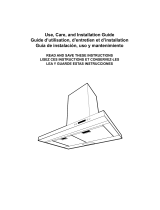
15
LISEZ CES INSTRUCTIONS ET CONSERVEZ-LES
Avis de sécurité important
ATTENTION
UTILISER CET APPAREIL À DES FINS DE VENTILATION
GÉNÉRALE SEULEMENT. NE PAS
UTILISER CET
APPAREIL POUR ÉVACUER DES MATÉRIAUX OU DES
VAPEURS DANGEREUX OU EXPLOSIFS.
AVERTISSEMENT
POUR RÉDUIRE LES RISQUES D’INCENDIE, DE CHOC
ÉLECTRIQUE ET DE BLESSURE, RESPECTER LES
DIRECTIVES SUIVANTES :
A. Utiliser cet appareil uniquement aux fins prévues par le
fabricant. Si vous avez des questions à propos de
l’appareil, communiquez avec le fabricant.
B. Avant de faire l’entretien de l’appareil ou de le nettoyer,
coupez l’alimentation dans le panneau électrique et
verrouillez le panneau en bloquant le dispositif
permettant d’empêcher d’activer l’alimentation
accidentellement. S’il n’est pas possible de verrouiller
l’accès au panneau, fixez une étiquette très voyante au
panneau électrique.
C. Une personne qualifiée doit effectuer l’installation et le
câblage des fils électriques en conformité avec tous les
codes et toutes les normes, y compris la cote de
résistance au feu.
D. Il est important de prévoir suffisamment d’air pour
assurer une bonne combustion de l’équipement de
chauffe et l’évacuation adéquates des gaz par le conduit
de cheminé afin de prévenir les refoulements d’air.
Respectez les directives et les normes de sécurité des
fabricants de l’équipement de chauffage, comme celles
publiées par la National Fire Protection Association
(NFPA), la American Society for Heating, Refrigeration
and Air Conditioning Engineers (ASHRAE) et le code
des autorités de votre région.
E. Au moment de couper ou de percer un mur ou un
plafond, assurez-vous de ne pas endommager la filerie
électrique ou tout autre accès à un service publique.
F. Il faut toujours évacuer à l’extérieur les systèmes à
conduit.
ATTENTION
Pour réduire les risques d’incendie et évacuer l’air
correctement, assurez-vous que le conduit mène à
l’extérieur; il ne faut pas évacuer l’air dans l’espace
entre les murs, dans les plafonds, dans les greniers, les
vides sanitaires ou les garages.
AVERTISSEMENT
POUR RÉDUIRE DES RISQUES D’INCENDIE, UTILISEZ
UNIQUEMENT DES CONDUITS EN MÉTAL.
Installez cette hotte en respectant toutes les exigences
mentionnées.
AVERTISSEMENT
Pour réduire les risques d’incendie et de choc
électrique, n’utilisez pas cette hotte avec un contrôleur
de vitesse à semi-conducteurs.
AVERTISSEMENT
POUR RÉDUIRE LES RISQUES D’INCENDIE DE
GRAISSE SUR LES CUISINIÈRES.
a) Ne laissez jamais la cuisinière sans surveillance
lorsqu’elle est réglée à une haute température. Les
débordements par bouillonnement causent de la fumée
et des débordements de gras qui peuvent s’enflammer.
Faites chauffer l’huile lentement, à une température
basse ou moyenne.
b) Faites toujours fonctionner la hotte lorsque vous utilisez
la cuisinière à une haute température ou que vous faites
flamber des aliments (P. ex. : crêpes Suzette, cerises
jubilées, bœuf au poivre flambé).
c) Nettoyez les hélices de ventilation fréquemment. Il ne
faut pas que la graisse s’accumule sur les filres ou les
hélices.
d) Utilisez le bon format de casserole. Utilisez toujours un
chaudron de taille approprié à l’élément de la cuisinière.
AVERTISSEMENT
POUR ÉVITER DE BLESSER QUELQU’UN LORS D’UN
INCENDIE DE GRAISSE SUR LA CUISINIÈRE, SUIVRE
LES CONSEILS SUIVANTS
a
:
a) ÉTOUFFER LES FLAMMES avec un couvercle aux
dimensions de la taque de cuisson, une tôle à biscuit ou
tout autre plateau métallique, puis couper le gaz ou
l’alimentation électrique de la cuisinière. FAIRE
ATTENTION A NE PAS SE BRÛLER. Si les flammes ne
s’éteignent pas immédiatement, QUITTER LA PIÈCE ET
APPELER LES POMPIERS.
b) NE JAMAIS PRENDRE EN MAIN UNE CASSEROLE
EN FEU, vous pourriez vous blesser.
c) NE PAS UTILISER D’EAU, y compris les essuies de
vaisselle ou les serviettes humides – une violente
explosion due à la vapeur formée pourrait survenir.
d) Utiliser un extincteur SEULEMENT si:
1) Vous êtes sûr d’avoir un extincteur de classe ABC que
vous savez utiliser.
2) Le feu est petit et confiné à la zone où il s’est formé.
3) Les pompiers ont été appelés.
4) Vous pouvez lutter contre le feu avec une sortie
derrière vous.
a
Recommandations tirées des conseils de sécurité en cas
d'incendie de cuisine publiés par la NFPA.
MODE OPéRATOIRE
a. Toujours laisser les grilles de sécurité et les filtres à leur
place. Sans la présence de ces derniers, les parties
aspirantes pourraient attirer les cheveux, les doigts ou
les vêtements.
Le fabricant décline toute responsabilité si les informations
détaillées dans ce manuel pour l’installation, l’entretien et
l’utilisation adéquate du produit ne sont pas observées. Le
fabriquant décline en outre toute responsabilité pour
d’éventuelles blessures dues à des négligences; en outre, la
garantie de l’appareil sera annulée suite à des conditions
d’entretien inappropriées. Cet appareil est fabriqué pour un
usage interne. Ne pas utiliser cet appareil à l’extérieur.





















